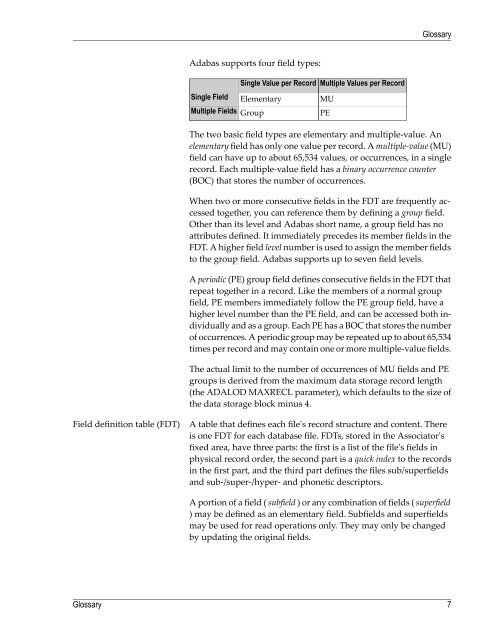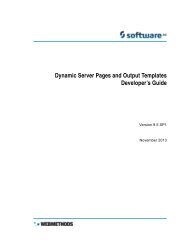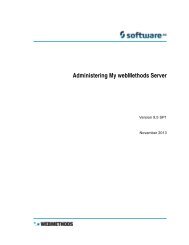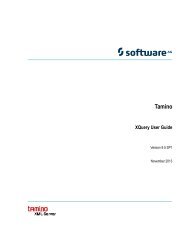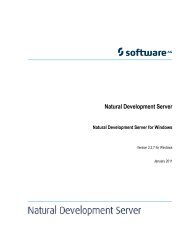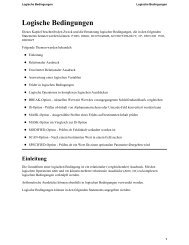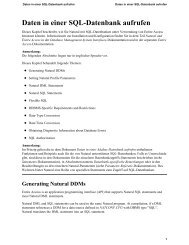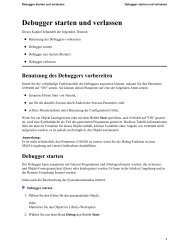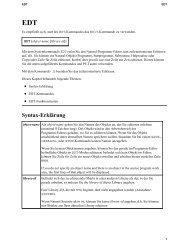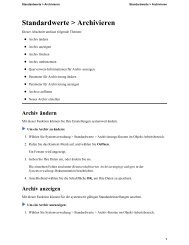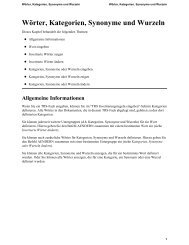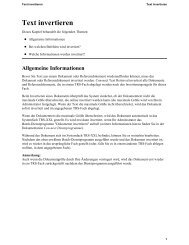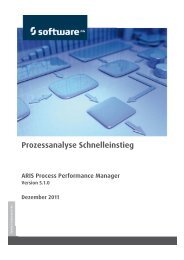Adabas Glossary - Software AG Documentation
Adabas Glossary - Software AG Documentation
Adabas Glossary - Software AG Documentation
You also want an ePaper? Increase the reach of your titles
YUMPU automatically turns print PDFs into web optimized ePapers that Google loves.
<strong>Adabas</strong> supports four field types:<br />
Single Field<br />
Single Value per Record<br />
Elementary<br />
Multiple Fields Group<br />
Multiple Values per Record<br />
MU<br />
PE<br />
The two basic field types are elementary and multiple-value. An<br />
elementary field has only one value per record. A multiple-value (MU)<br />
field can have up to about 65,534 values, or occurrences, in a single<br />
record. Each multiple-value field has a binary occurrence counter<br />
(BOC) that stores the number of occurrences.<br />
When two or more consecutive fields in the FDT are frequently accessed<br />
together, you can reference them by defining a group field.<br />
Other than its level and <strong>Adabas</strong> short name, a group field has no<br />
attributes defined. It immediately precedes its member fields in the<br />
FDT. A higher field level number is used to assign the member fields<br />
to the group field. <strong>Adabas</strong> supports up to seven field levels.<br />
A periodic (PE) group field defines consecutive fields in the FDT that<br />
repeat together in a record. Like the members of a normal group<br />
field, PE members immediately follow the PE group field, have a<br />
higher level number than the PE field, and can be accessed both individually<br />
and as a group. Each PE has a BOC that stores the number<br />
of occurrences. A periodic group may be repeated up to about 65,534<br />
times per record and may contain one or more multiple-value fields.<br />
The actual limit to the number of occurrences of MU fields and PE<br />
groups is derived from the maximum data storage record length<br />
(the ADALOD MAXRECL parameter), which defaults to the size of<br />
the data storage block minus 4.<br />
Field definition table (FDT) A table that defines each file's record structure and content. There<br />
is one FDT for each database file. FDTs, stored in the Associator's<br />
fixed area, have three parts: the first is a list of the file's fields in<br />
physical record order, the second part is a quick index to the records<br />
in the first part, and the third part defines the files sub/superfields<br />
and sub-/super-/hyper- and phonetic descriptors.<br />
<strong>Glossary</strong><br />
<strong>Glossary</strong><br />
A portion of a field ( subfield ) or any combination of fields ( superfield<br />
) may be defined as an elementary field. Subfields and superfields<br />
may be used for read operations only. They may only be changed<br />
by updating the original fields.<br />
7


